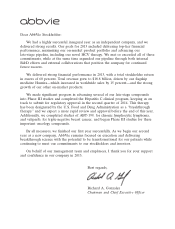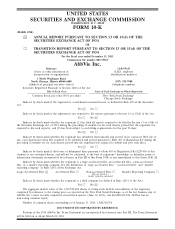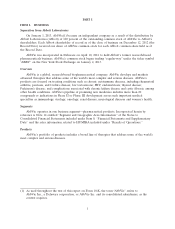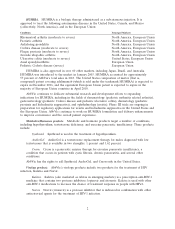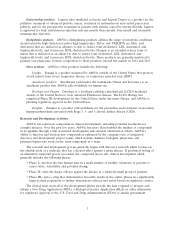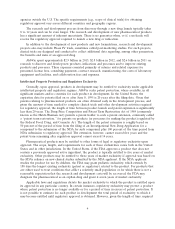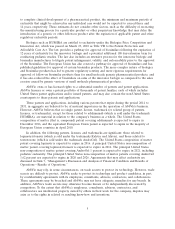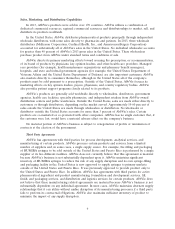AbbVie 2013 Annual Report Download - page 7
Download and view the complete annual report
Please find page 7 of the 2013 AbbVie annual report below. You can navigate through the pages in the report by either clicking on the pages listed below, or by using the keyword search tool below to find specific information within the annual report.Endocrinology products. Lupron (also marketed as Lucrin and Lupron Depot) is a product for the
palliative treatment of advanced prostate cancer, treatment of endometriosis and central precocious
puberty, and for the preoperative treatment of patients with anemia caused by uterine fibroids. Lupron
is approved for daily subcutaneous injection and one-month, three-month, four-month and six-month
intramuscular injection.
Dyslipidemia products. AbbVie’s dyslipidemia products address the range of metabolic conditions
characterized by high cholesterol and/or high triglycerides. TriCor and TRILIPIX are fibric acid
derivatives that are indicated as adjuncts to diet to reduce total cholesterol, LDL cholesterol, and
triglyceride levels, and to increase HDL cholesterol levels. Niaspan is an extended release form of
niacin that is indicated as an adjunct to diet to reduce total cholesterol, LDL cholesterol, and
triglyceride levels, and to increase HDL cholesterol levels. These products are primarily marketed to
primary care physicians. Generic competitors to these products entered the market in 2012 and 2013.
Other products. AbbVie’s other products include the following:
Synagis. Synagis is a product marketed by AbbVie outside of the United States that protects
at-risk infants from severe respiratory disease, or respiratory syncytial virus (RSV).
Anesthesia products. Sevoflurane (sold under the trademarks Ultane and Sevorane) is an
anesthesia product that AbbVie sells worldwide for human use.
Duodopa and Duopa. Duodopa is a levodopa-carbidopa intestinal gel (LCIG) marketed
outside of the United States to treat advanced Parkinson’s disease. The LCIG therapy has
completed Phase III development for the United States under the name Duopa, and AbbVie is
pursuing regulatory approval in the United States.
Zemplar. Zemplar is a product sold worldwide for the prevention and treatment of secondary
hyperparathyroidism associated with Stage 3, 4, and 5 chronic kidney disease (CKD).
Research and Development Activities
AbbVie has numerous compounds in clinical development, including potential treatments for
complex diseases. Over the past five years, AbbVie has more than doubled the number of compounds
in its pipeline through a mix of internal development and external collaboration efforts. AbbVie’s
ability to discover and develop new compounds is enhanced by the company’s use of integrated
discovery and development project teams, which include chemists, biologists, physicians, and
pharmacologists who work on the same compounds as a team.
The research and development process generally begins with discovery research which focuses on
the identification of a molecule that has a desired effect against a given disease. If preclinical testing of
an identified compound proves successful, the compound moves into clinical development which
generally includes the following phases:
• Phase I—involves the first human tests in a small number of healthy volunteers or patients to
assess safety, tolerability and potential dosing.
• Phase II—tests the drug’s efficacy against the disease in a relatively small group of patients.
• Phase III—tests a drug that demonstrates favorable results in the earlier phases in a significantly
larger patient population to further demonstrate efficacy and safety based on regulatory criteria.
The clinical trials from all of the development phases provide the data required to prepare and
submit a New Drug Application (NDA), a Biological License Application (BLA) or other submission
for regulatory approval to the U.S. Food and Drug Administration (FDA) or similar government
3



